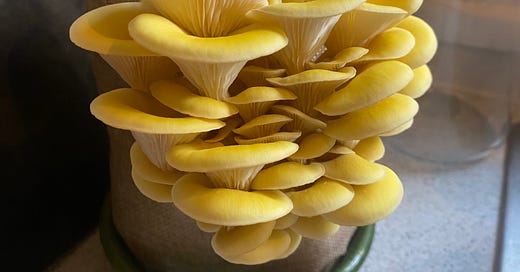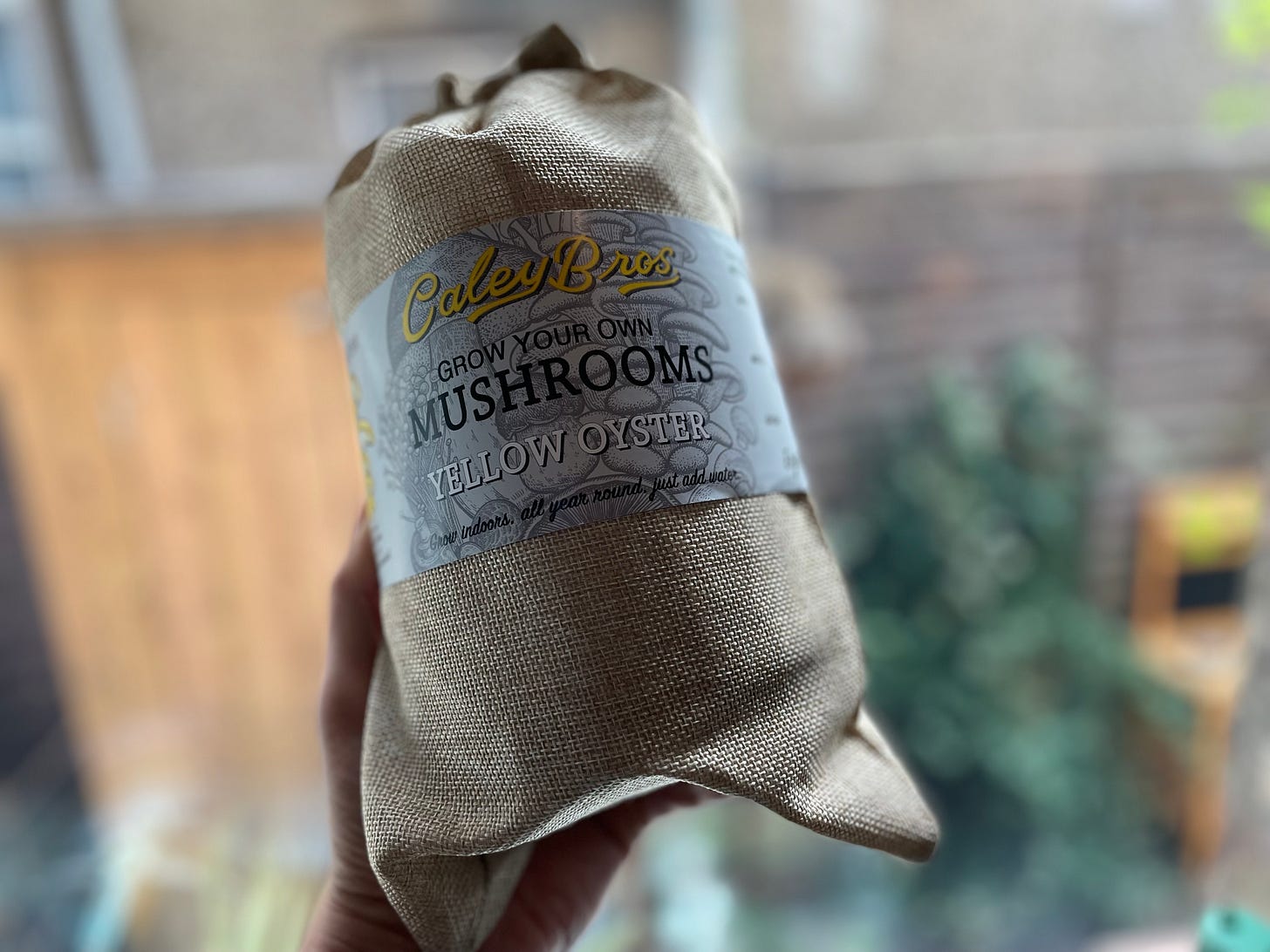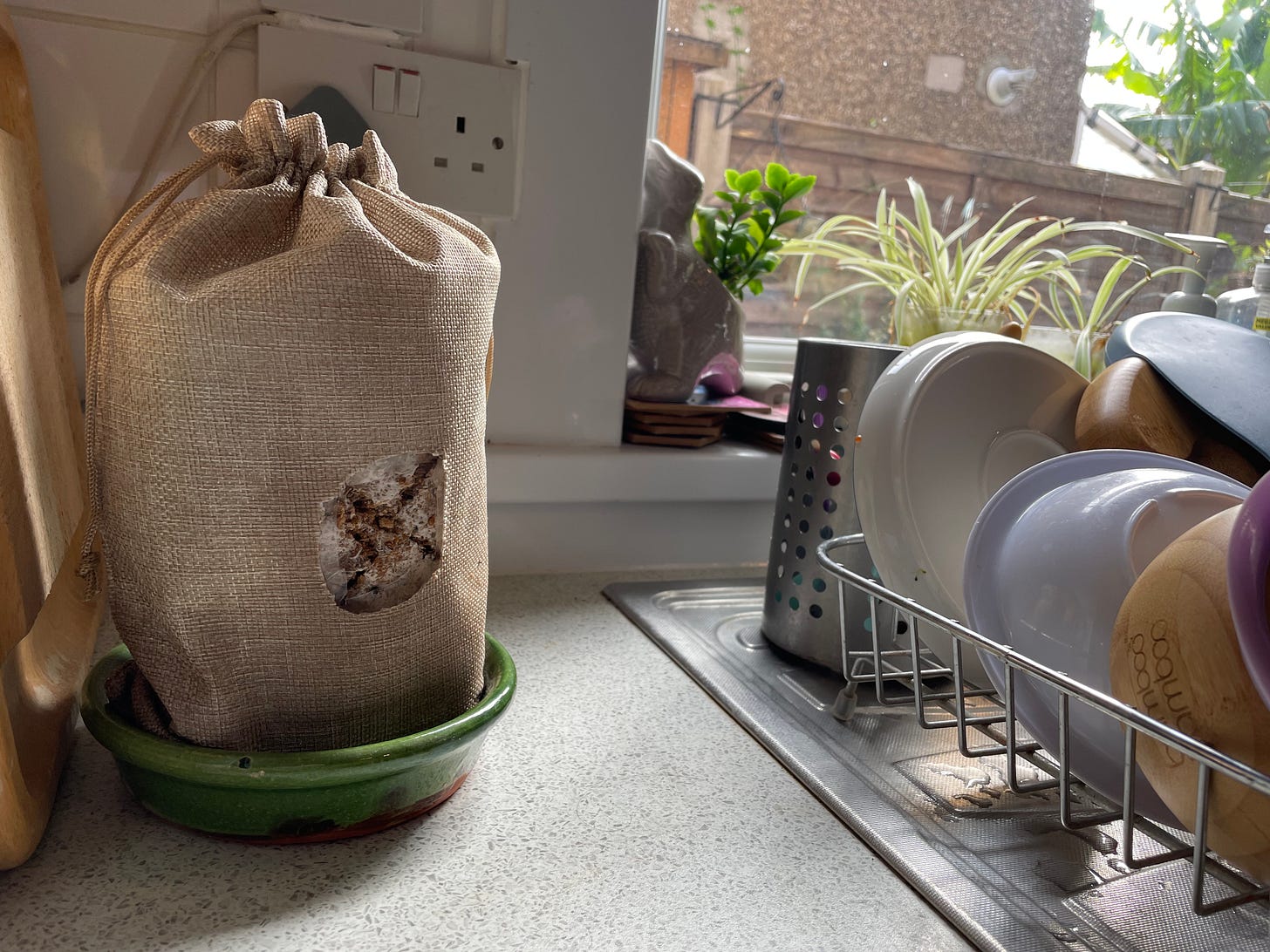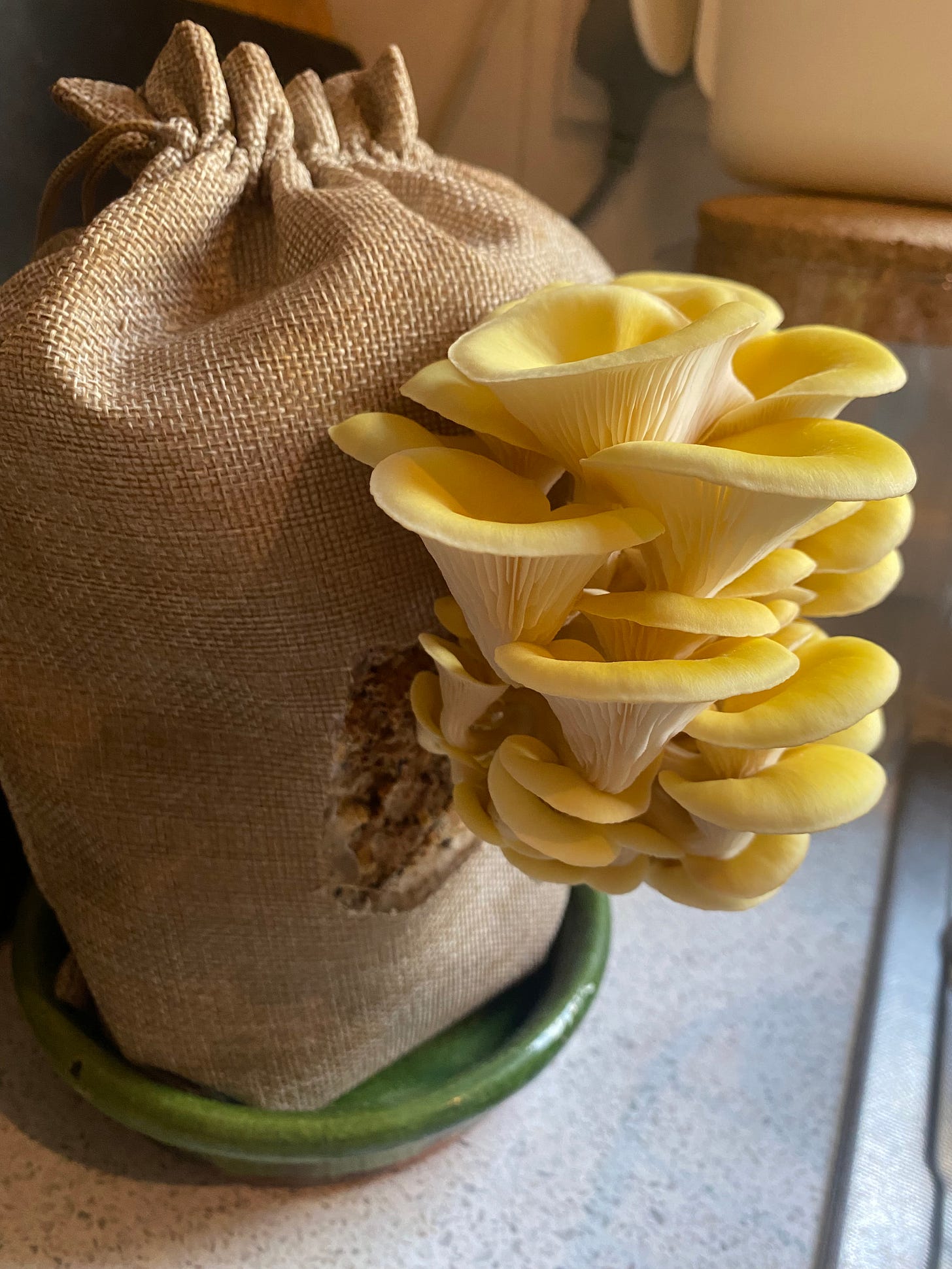Fungus Amongus
Charting the magical, gastronomical and ridiculously simple process of growing your own edible mushrooms
Before we tuck into the mushroomy meat of this week’s post, I wanted to share some happy news. It gives me great pleasure to announce that my output here on The Earthworm has been recognised for a prize at the annual Garden Media Guild awards. The category: Digital Gardening Writer of the Year. I’m up against some stiff competition and probably won’t win. But that doesn’t matter. The most important thing, as with any awards do, is that I have an excuse to attend a swanky ceremony, don my glad rags and drink complimentary champagne. Cheers!
I’ve got mushrooms on my mind.
Here in the UK, we are well and truly into mushroom season. Pictures of dazzling fungi are all over my Instagram feed, my neighbourhood Whatsapp groups, and national news sites. (Not to mention the darker side of shrooms, such as the chilling story from Australia where a woman has been charged with multiple counts of murder after feeding deathcap mushrooms to her dinner guests; or the HBO TV series The Last Of Us, which I’m binge-watching at the moment and places fungi at the heart of its eerie, post-apocalyptic narrative.)
Here in East London, meanwhile, there was bad news this week for the local fungus foraging community, as enthusiasts were warned not to pick mushrooms from the wet woodland floor of nearby Epping Forest, lest they face prosecution and criminal charges.
On the face of it, such a heavy-handed approach to dealing with foragers – most of whom are surely among the nerdiest nature lovers in the land – seems more than a little harsh. Especially when you consider that gathering goodies from the wild is written into our animal DNA; that it is our most ancient way of feeding ourselves; not to mention that in this corner of one of the world’s great grey metropolises, many people don’t actually have access to an outdoor space in which they can grow – rather than purchase or purloin – their food.
Then again, as reported this week on the BBC News website:
“[Epping Forest] is home to 440 rare and endangered fungi species. Conservationists say picking them damages the valuable forest biodiversity that has developed over the past 10,000 years. They are also a valuable food source for animals, such as deer, and many rare insect species depend on them for survival.”
A criminal record still seems on the severe side for someone filling their pockets with jelly ears and tawny grisettes. But as ever, there are idiots out there intent on taking it too far. Way too far. Idiots like the egregious entrepreneur recently caught exiting Epping Forest with a carload of 49kg (108lbs) of foraged fungi – roughly the equivalent of 250 punnets of supermarket shrooms. I mean, way to ruin it for the rest of us, mate.
Well, I say “us”. As it happens, I’ve never been much interested in foraging for mushrooms. Elderflower, absolutely. Wild garlic, definitely. Blackberries, a billion per cent yes. But not mushrooms. I could put this down to a lack of knowledge; a risk-averseness that prevents me from picking toadstools lest they turn out to be poisonous.
But the truth is, I’ve just never liked eating mushrooms. Too squidgy, too slimy, too… fungusy. Not for me. Which has been awkward at times during this past decade of vegetarianism. Most notably when dining out in cafes, pubs and restaurants, where vegetarians and vegans are still faced with a limited range of mushroom-heavy menu staples such as mushroom risottos, mushroom burgers and mushroom wellingtons. Yuck. No thanks. Nuh-uh.
So, given my lifelong distaste for consuming fungi, it might surprise you to learn of my latest food growing endeavour: yellow oyster mushrooms. I blame Lorraine Caley.
Lorraine is one half of the sister-sister team behind The Caley Brothers. (I know what you’re thinking – Lorraine and Jodie’s business is in fact named after their grandparents’ grocery store.) The Caley Bros is one of a rapidly rising number of grow-at-home mushroom kit purveyors, with a focus on indoor growing.
These businesses make a point of offering accessible, foolproof kits for growing your own uncommonly available mushroom varieties, such as lion’s mane, shiitake, pink oyster and others, occupying an interesting space in the Venn diagram between house plants on one side, and fruit and veg on the other. Kits such as these offer us an insight into the world of edible fungi – about which even the most experienced of gardeners probably knows next to nothing.
I interviewed Lorraine Caley for the current issue of the RHS’s membership magazine The Garden, and she opened my eyes – no, blew my mind – to the wonderful world of indoor mushroom growing. Moments after ending our Zoom call, I’d ordered a grow-at-home kit. A few weeks later (kits are sent out in batches, usually once a month), my plastic-wrapped, hessian-shrouded block of inoculated substrate arrived. All I had to do was cut open the plastic, place it in a bright spot out of direct sunlight, mist the thing two or three times a day, and watch the miracle of fungal life unfold before my eyes.
It is without a doubt the simplest and most satisfying grow-your-own experience I have had. The Caley Brothers (other grow-at-home mushroom kit purveyors are available!) guarantee a first flush of harvestable shrooms, and I did find the process to be fairly foolproof. For example, unlike indoor plants, you can’t overwater the mycelium (the stringy white “roots” or “branches” of the fungus), which is great news for anybody with a track record of drowning supposedly “unkillable” houseplants.
But best of all, if you are a chronically impatient millennial such as I am, is the sheer speed of the process. On October 5th, I exposed my kit to the light, triggering the mycelium to put energy into creating its reproductive body, ie, mushrooms. On October 13th, a little yellow-white lump appeared on the surface of the substrate. From here on out, things got blink-and-you’ll-miss-it quick.
The mushrooms doubled in size every 12-24 hours. Doubled. This exponential growth was so lightning fast that, at times, we suspected that if we were to sit and stare at the kit for a few minutes, we would actually be able to see the mushrooms swell.
Then, six days after those first signs of fungal fruit – and just two weeks after opening the kit – we were harvesting our beautiful, otherworldly, coral-like, sunshine yellow oyster mushrooms.
There are all sorts of ways that you can cook oyster mushrooms, but we wanted to make sure we could really taste them, so we simply pan fried our crop in butter and garlic. And you know what? I didn’t mind them at all. In fact, I quite liked them. There was none of that gooey, chewy ickiness that I normally associate with mushrooms. No sliminess whatsoever. The flavour was delicate, and just a little bit earthy. I would absolutely grow and eat them again.
Indoor mushroom growing might just be The Next Big Thing. And why not? You don’t need any knowledge or specialist equipment; you don’t need much space, let alone a garden; and you can grow them all year round, including at times when most people’s veg patches (if they’re lucky enough to have one) are sitting dormant and bare.
There was, however, one downside to my debut at-home mushroom-growing experience. Namely, the price. Generally speaking, one of the main draws of growing your own fruit and veg is that it tends to work out cheaper than going to the shops. That isn’t necessarily the case with these mushrooms. The yellow oyster mushroom kit that I bought set me back the princely sum of £22.50 (including shipping). Now that I have harvested my first flush of mushrooms, I can (and will) go for a second, and even a third flush, but unlike the first, these are not guaranteed.
Still, scarcity has a value, and I can't remember the last time I saw yellow or pink oyster mushrooms, or lion's mane, or any of the other popular grow-at-home varieties for that matter, on sale at my local supermarket. So yes, I will be purchasing another kit. If nothing else, they make for a very beautiful (albeit short-lived) kitchen counter ornament.
Beyond that, I’d like to try growing them outdoors. You can readily purchase inoculated dowels – basically bits of wood impregnated with fungal spores. These you can then insert into any stump or log that you may (or may not) have lying about in your garden. Keep this wet, as you might any outdoor-dwelling pot plant, and a few months later you can be feasting on the fungal spoils.
Growing mushrooms outside is a lengthier and more involved process, and carries none of the guarantees of the indoor kits, but if it works, it really works. A decaying log provides far more sustenance for the mycelium than a little indoor countertop kit ever could, meaning larger crops extending over a period of weeks, if not months.
Or if all of that sounds too complicated, too time-consuming, too expensive, then just head out this weekend to your local park/field/cemetery/woodland and take your pick of nature’s bounty. But for the love of all things mycelial, if you do, be careful.
Have you ever (deliberately!) grown your own mushrooms, indoors or out? If so, what? And how did you get on?









Happy to hear that you enjoyed your mushrooms. I'm a big mushroom fan but Brooke, like you, isn't a fan of the texture. I guess everything tastes a little better (or has more agreeable texture?) when you grow it yourself! And congrats on the award recognition!
Thanks Boaz! And yes I think you’re probably right - a bit like a proud parent, the satisfaction of having grown something from (sort of) nothing does make you much more tolerant of its taste/texture/appearance!